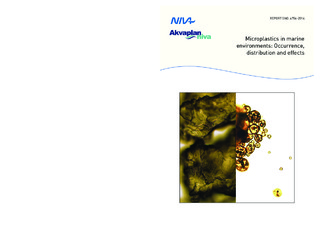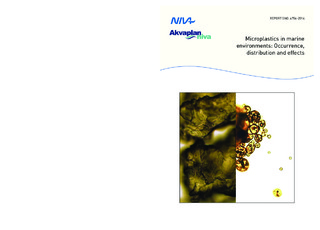| dc.contributor.author | Nerland, Inger Lise | |
| dc.contributor.author | Halsband, Claudia | |
| dc.contributor.author | Allan, Ian | |
| dc.contributor.author | Thomas, Kevin V | |
| dc.contributor.other | Thomas, Kevin V - Project manager | |
| dc.date.accessioned | 2015-05-18T12:00:33Z | |
| dc.date.accessioned | 2015-05-22T06:59:27Z | |
| dc.date.available | 2015-05-18T12:00:33Z | |
| dc.date.available | 2015-05-22T06:59:27Z | |
| dc.date.issued | 2014 | |
| dc.identifier | 6754 | |
| dc.identifier.citation | NIVA-rapport. 71 p. Norsk institutt for vannforskning, 2014 | nb_NO |
| dc.identifier.isbn | 978-82-577-6489-0 | |
| dc.identifier.issn | 1894-7948 | |
| dc.identifier.uri | http://hdl.handle.net/11250/283879 | |
| dc.description | - | nb_NO |
| dc.description.abstract | This report reviews the current understanding of the occurrence, distribution and effects of microplastics on the marine environment.
Most members of the public are aware of, or have seen the impacts of, litter
pollution on the marine environment, so common are scenes of beaches
covered in litter. The extent of this pollution is such that the amount of
marine litter found along the Norwegian coast and the coast of Svalbard has
been described as unacceptable. Much of this litter is in the form of plastic,
with global use and production steadily increasing since mass production
started in the 1940s, annual global production is now close to 300 million
tonnes. What we don’t see is plastic in the form of very small particles, socalled
‘microplastics’ that pollutes much of the marine environment. This
report reviews the current understanding of the occurrence, distribution and
effects of microplastics on the marine environment. | nb_NO |
| dc.description.abstract | Plastbruk og produksjon har økt dramatisk de siste 65 årene. Plastprodukter er med på å bedre
livskvaliteten til mennesker over hele verden, men rundt 50 % av plastproduktene er engangsprodukter
som dermed genererer en betydelig mengde avfall. Plastsøppel, som følge av uheldig håndtering av
plastprodukter, er et stort globalt miljøproblem. De fleste plasttypene er kjemisk inert materiale som er
tungt nedbrytbart i det marine miljø. Tilstedeværelsen av søppel i det marine miljøet har en direkte negativ
innvirkning på marine arter; det kan føre til drukning av marine pattedyr som vikler seg inn i det og også
inntak av plastsøppelet (misoppfatter det for føde).... | |
| dc.description.sponsorship | Miljødirektoratet | nb_NO |
| dc.language.iso | eng | nb_NO |
| dc.publisher | Norsk institutt for vannforskning | nb_NO |
| dc.relation.ispartofseries | NIVA-rapport;6754 | |
| dc.rights | Navngivelse-Ikkekommersiell-DelPåSammeVilkår 3.0 Norge | * |
| dc.rights.uri | http://creativecommons.org/licenses/by-nc-sa/3.0/no/ | * |
| dc.title | Microplastics in marine environments: Occurrence, distribution and effects | nb_NO |
| dc.title.alternative | Mikroplast i marine miljøer. Forekomst, utbredelse og effekter | nb_NO |
| dc.type | Research report | nb_NO |
| dc.date.updated | 2015-05-18T12:00:33Z | |
| dc.rights.holder | Norsk institutt for vannforskning / Norwegian institute for water research | |
| dc.subject.nsi | VDP::Matematikk og naturvitenskap: 400 | nb_NO |
| dc.subject.nsi | VDP::Mathematics and natural scienses: 400 | nb_NO |
| dc.identifier.cristin | 1182007 | |
| dc.subject.keyword | Marin forsøpling / Marin pollution | |
| dc.subject.keyword | Microplast / Microplastic | |
| dc.subject.keyword | Negativ miljøpåvirkning / Negative environmental impact | |
| dc.subject.keyword | Verdensomspennende / Worldwide | |
| dc.relation.project | 14338 | nb_NO |


